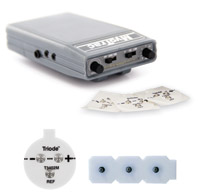How EMG Works

MyoTrac EMG device
& EMG electrodes
For all practical purposes, surface EMG
and invasive needle EMG are used for entirely
different purposes. Surface EMG is a day-to-day
clinical tool and is not intended to replace
needle electrodes as used in routine medical
electrodiagnostics. Invasive, needle EMG is
primarily used as a diagnostic tool to detect
very subtle changes of electrical muscle
activities. to determine underlying disease
processes. Electrodiagnostics may determine that
a patient has a thyroid problem, or muscular
distrophy, or nerve compression.
Surface EMG on the other hand, is used as a
therapeutic tool in two major treatment areas.
First, surface EMG is used for biofeedback
relaxation. Relaxation applications have a long
history and are in common usage. Second, EMG is
used in rehabilitation. Rehabilitation
applications are only now coming into their own.
For example, an EMG device can give a patient
feedback on how hard he or she is exercising an
injured muscle. Especially in the early stages of
rehabilitation, when it is inadvisable to work
against weights, EMG is the only good way to get
good information on how hard the patient is
working. This informs the clinician
quantitatively of the degree of progress being
achieved and gives the patient motivation to work
diligently at the required work routines.
- Evaluation of muscle function The quantification of weakness
used as a baseline to test improvement
with therapy. Often an EMG device can
detect a very weak voluntary muscle
movement which can lead to significant
rehabilitation which might otherwise be
neglected.
- Evaluation of motor control problems For example, an EMG
device can be used to identifiy the
location of and quantify the degree of
spastic muscle activity following stroke,
cerebral palsy, spinal cord injury, etc.
- Muscle training, such
as training a patient to contract the
quadriceps while in a cast following knee
surgery or during uncasted exercise,
especially in the early stages when
weights cannot be safely used to quantify
the strength of the exercise.
|